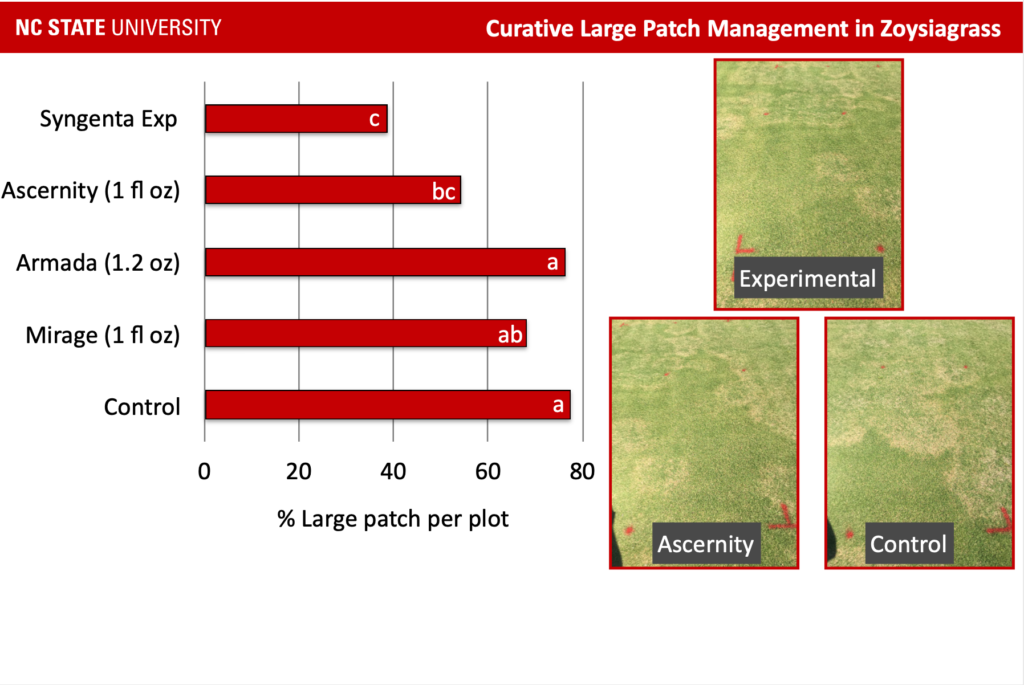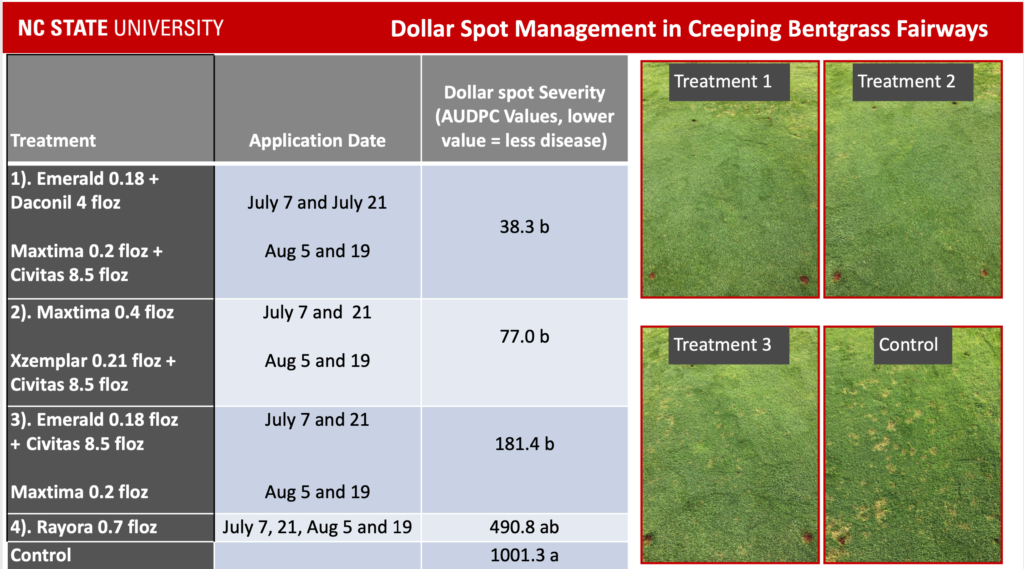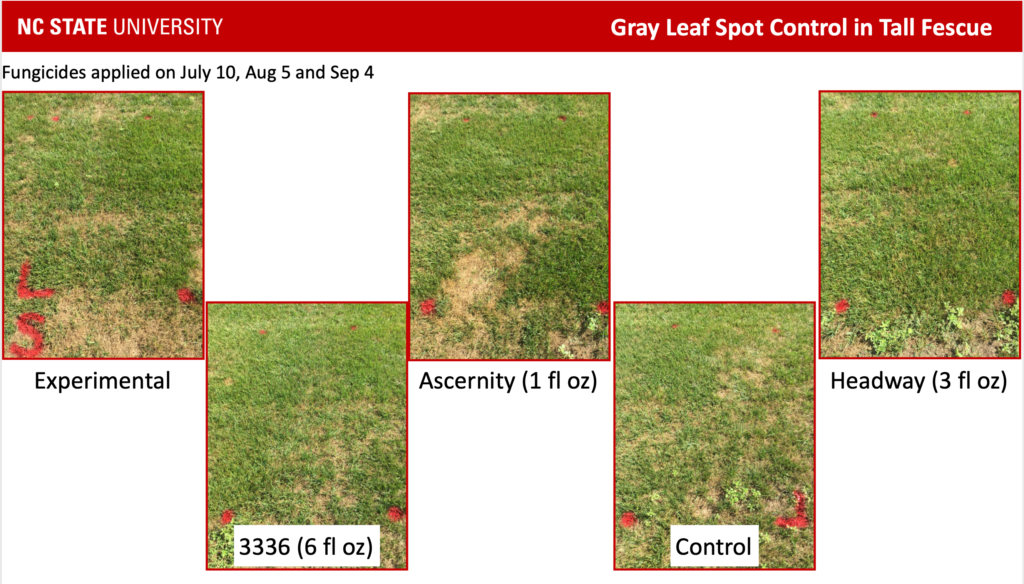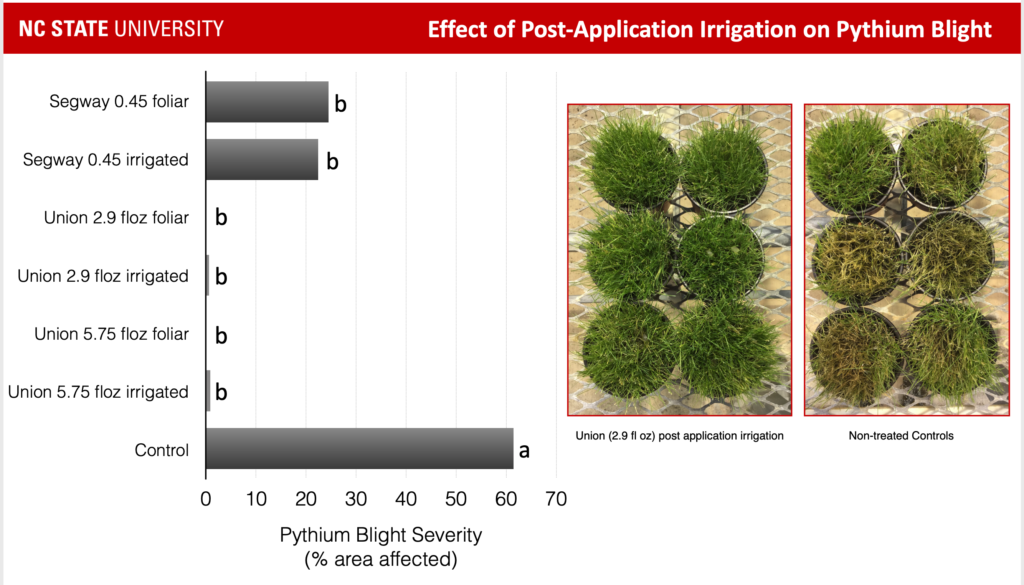Review of Turf Pathology Fungicide Trials From 2020
go.ncsu.edu/readext?742983
en Español / em Português
El inglés es el idioma de control de esta página. En la medida en que haya algún conflicto entre la traducción al inglés y la traducción, el inglés prevalece.
Al hacer clic en el enlace de traducción se activa un servicio de traducción gratuito para convertir la página al español. Al igual que con cualquier traducción por Internet, la conversión no es sensible al contexto y puede que no traduzca el texto en su significado original. NC State Extension no garantiza la exactitud del texto traducido. Por favor, tenga en cuenta que algunas aplicaciones y/o servicios pueden no funcionar como se espera cuando se traducen.
Português
Inglês é o idioma de controle desta página. Na medida que haja algum conflito entre o texto original em Inglês e a tradução, o Inglês prevalece.
Ao clicar no link de tradução, um serviço gratuito de tradução será ativado para converter a página para o Português. Como em qualquer tradução pela internet, a conversão não é sensivel ao contexto e pode não ocorrer a tradução para o significado orginal. O serviço de Extensão da Carolina do Norte (NC State Extension) não garante a exatidão do texto traduzido. Por favor, observe que algumas funções ou serviços podem não funcionar como esperado após a tradução.
English
English is the controlling language of this page. To the extent there is any conflict between the English text and the translation, English controls.
Clicking on the translation link activates a free translation service to convert the page to Spanish. As with any Internet translation, the conversion is not context-sensitive and may not translate the text to its original meaning. NC State Extension does not guarantee the accuracy of the translated text. Please note that some applications and/or services may not function as expected when translated.
Collapse ▲We had many interesting fungicide trials in summer of 2020 and we are looking forward to discussing some of the new and exciting products as they get closer to market. Overall, our fungicide testing trial program was down due to the coronavirus, yet we still had some very interesting trials. Most of what was submitted to our program were experimental materials and many performed quite well. One of the most exciting was an experimental material that completely suppressed Pythium root rot on creeping bentgrass. We were excited to see this because Segway by itself struggled some this year with the frequent rains since July. I know it is a tease to mention this material, but it is still early on in the discovery process and we are hoping it will continue to work its way to the market.
Curative Large Patch Control
We examined the curative properties of a few fungicides for large patch in the spring. These products included an experimental from Syngenta, Ascernity, Armada, and Mirage. We started this trial when large patch was severe, averaging around 70% disease in the trial area! A single application of each fungicide was applied on March 25th and disease was quantified for the next 27 days.

Typically, with this amount of disease, curative suppression will be limited at best. However, Syngenta’s experimental and Ascernity reduced large patch to 38% and 54% respectively. The non-treated control remained at 77% on average for the duration of the trial. We observed the reduction in disease over a 27-day period for the experimental and Ascernity only, but the experimental product showed curative suppression within 14 days of the application. Given these results, Ascernity and the new experimental will be staples for large patch management in warm-season grasses. Armada and Mirage did not suppress large patch curatively, however these products have performed well in preventative large patch trials in the past. As a reminder, preventative applications for large patch should start in the fall when soil temperatures drop to 80oF for centipegrass and St. Augustinegrass and at 70oF for zoysiagrasses.
For more information about large patch, please consult the following: Large Patch Management & Control
Dollar Spot Management in NC Mountains
For the second year in a row, we conducted a dollar spot trial at Hound Ears Club in Boone, NC. Although we observe excellent dollar spot pressure in Raleigh, we have been conducting trials in the mountains to demonstrate fungicide efficacy in a real-world environment. Moreover, many courses in the NC mountains have documented resistance to propiconazole which adds another interesting twist to the trial.
This year, we examined a few dollar spot programs from BASF and they performed well. All of the program treatments suppressed dollar spot when compared to the untreated control plots. This is typical of what we have observed in the past that stand-alone products may not perform well in this environment. Maxtima, BASF’s new DMI, has continued to provide excellent dollar spot suppression which was evident in this trial.
For more information about dollar spot, please consult the following: Dollar Spot Management & Control
Gray Leaf Spot Management in Tall Fescue
Gray leaf spot was problematic in 2020 on tall fescue swards. This disease continues to ravage tall fescue and we are still searching of a viable strategy to manage this disease.
The images clearly show a promising experimental product from Syngenta, but also demonstrate that mixtures such as Ascernity and Headway performed well in terms of gray leaf spot suppression. Nothing provided 100% control, so next year we will have to investigate a programmatic approach to gray leaf spot management. Given the severity of gray leaf spot recently, Headway should strongly be considered as a backbone in a tall fescue fungicide program.
For more information about gray leaf spot, please consult the following: Gray Leaf Spot Management & Control
Effect of Post-Application Irrigation on Pythium Blight
Finally, we conducted an interesting greenhouse trial early in 2020 on Pythium blight management in perennial ryegrass. The goal of this trial was not to see if Segway or Union would perform well on Pythium blight, but rather to see if post-application irrigation affects control.
Not surprisingly, excellent products such as Segway or Union provided exceptional Pythium blight control regardless of whether they were irrigated in or not. Although we did not see differences between the Segway treated pots and Union treated pots, Union over all had less disease. This was to be expected given Union is a combination of cyazofamid and azoxystrobin. This trial provides further evidence that irrigating fungicides in does not affect foliar disease control.





